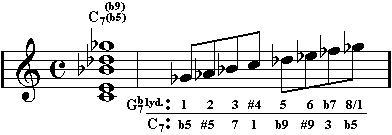First Double Alteration: Dominant Flat 9, Flat 5
We will discuss three ways to solo over a Dominant Flat 9, Flat 5 chord:
1) The bi-tonal triad
2) The tri-tone dominant substitution
3) Diminished scales and arpeggios
The Bi-tonal Triad
The C7 Flat 9, Flat 5 (also nomenclated C7 Flat 9, Sharp 11) is bi-tonal. The bi-tonal triad is G flat major. It is most easily visualized from a close position voicing:

The following phrase is based on the G flat triad. When adding notes to the triad, the added notes must be consonant with the parent chord. In the phrase below:
Bar 1:
The Ab is the sharp 5 of C.
G-natural would clash with the Gb in the chord.
A-natural would clash with the Bb in the chord.
Bar 2:
The C is the Lydian 4th of Gb. A regular 4th wouldn't work because B-natural would clash with the Bb in the chord, plus the C is the root of the chord.
Bar 3:
The E is the 3rd of C - the strongest note in the chord
(see the left text box on the Target Notes page).

The above phrase illustrates that when you add the 2 (bar 1), the sharp 4 (bar 2), and the flat 7 (bar 3), to the bitonal triad (Gb), a scale is created called
Lydian-Dominant. Here is a C Lydian-Dominant scale:

The Lydian-Dominant scale would be applied to the tri-tone substitution chord (see below: "The Tri-tone Dominant Substitution").
Here's the Gb Lydian-Dominant scale with it's
scalar relationship to C7, Flat 9, Flat 5:

Here's a couple of examples of a Lydian-Dominant scale in a II - V - I context:
Example 1:

Example 2:

The Tri-tone Dominant Substitution
If we add the E (the 3rd of the C7), we have an E, Bb Db, Gb. That spells a 3rd inversion Gb7 chord. This gives rise to the maxim: The more you alter a Dominant chord, the more like its tri-tone it becomes. So arpeggio-based soloing based on Gb7 can be used over C7 Flat 9, Flat 5.

Here are three phrases based on the tri-tone substitution, Gb7.
Example 1:

Example 2:

Example 3:

II - V - I Examples
The tri-tone substitution is a very common device used in arranging schemes, as well as a device to create more harmonically interesting solos. For instance, Flat II Dominant is a substitute for V. So Dmi7, G7, Cmaj7 becomes Dmi7, Db7, Cmaj7. When you solo using a Db7 over a G7, your line implies a G7 flat 9, flat 5.
Example 1:

Example 2:

Now we're going to visit Autumn Leaves again. This time we are going to use the tri-tone substitution for the Dominant chords. So over the D7 we'll construct our line based on Ab7. Over the B7 we'll use F7 for our line.

Diminished Scales and Arpeggios
Since a flat 9 is involved a diminished scale/arpeggio will also work (see the Dominant Flat 9 page). The diminished scale also includes the flat 5 as well as the natural 5. If the chord is actually a flat 9, flat 5 you need to be careful about playing the natural 5th. Use it as a leading tone. The most common diminished pattern is based off the third of the C7 (E Diminished) or the 7th of the C7 (Bb Diminished).

Example 1:

Example 2:

For II - V - I examples see the Dominant Flat 9 page.



